View current page
...more recent posts
Interesting article in Wired on the "shadow internet"--haven't read it all yet but am intrigued by what it's saying about file-sharing being an alternate form of broadcasting. Only a tiny portion of peer to peer file sharing consists of people ripping CDs and putting them online--mostly it's the same few pirated (crappy) CDs or movies spreading virally really fast. This suggests that the RIAA and MPAA lawsuits are a worse than useless form of kicking-the-dog--like going after pot smokers because crack dealers are hard to catch. Or maybe that's not a good analogy: maybe it's like going after Perrier-sharers because you can't have a global monopoly on tap water.
Old School Techno from Dallas, Part 2
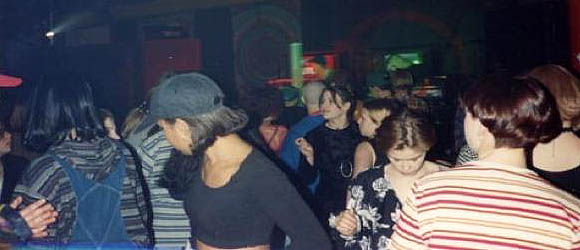
Ravestock '94, Dallas. That is seriously a lot of stripes. And girls.
x-eleven "Ecstasy" 1992 [mp3 removed]

Previous post on x-eleven is here. Since it was written, Gary Wicker has put up some more tracks, including "Ecstasy," the one highlighted above. Not sure where it's going at first, the sampled "ooh" sounds silly, but at the 90 second mark it grabs your attention, and at 120 seconds, when the Larry Heard-ish house part with the synth-flute kicks in and those "oohs" become joyful, stuttering vocal science, it really takes off. Some of the appeal is rooted in time travel but this is among the happiest music you'll hear, and Wicker feeds the retrograde desire to hear lots of arpeggios played at high speed. Haven't checked out Todd Hixon's videos yet, also from the vault, but will--just wanted to get this track up. It's weird, I'm nostalgic for a scene I never participated in, except in my studio listening to these tunes on the radio. I moved to NY the next year and found drum and bass everywhere--right about the time Wicker sold his gear and stopped making x-eleven tracks. "Ecstasy" is earlier--'92. Update, December 2014: The X-Eleven links above are dead but the group has a page on bandcamp.
I'm trying to set up a music studio and it's slow and frustrating as hell. There's a reason I use simple-minded programs in my visual work--I want the tech to be fast and uncomplicated, and then I compensate by doing something ridiculously labor-intensive on the physical end. So far I've had a similar approach to music, somewhat in reverse: using entry level programs and the computer's sound card but mousing in the entire composition note by note on an old fashioned staff. One of my family members said, "Yeah, but it's the same four notes over and over!" I tried to explain that there are timbral variations that make the work similar to my sphere paintings, which this person likes, and exciting octave jumps, and subtle things with syncopation, and...well.
The problem is I'm tired of the textures of the low end music programs and want the sound to get richer. I love the Sidstation synthesizer I bought recently and think it deserves better accompaniment than the sound card synths in the shareware program I downloaded. I'm tired of buzz and hum in the recording. I want better bass and drum sounds. I want a real sequencer.
Before Christmas I bought a sampler from craigslist: an E-mu E6400 Classic. I've been playing with it tonight and it's been fun learning how a 9 year old sampler works but, actually, I'm not sure it does work. I managed to record a 1-second sample but couldn't save it. This machine has no internal hard drive, so my options are to hook a scuzzy (SCSI) cable up to a zip drive or CD ROM, neither of which I have, get an adapter card and enter "Scuzzy Hell" trying to get my PC to read it, or use the floppy drive to store small bits of data. Watching this thing slo-o-owly format a floppy was discouraging, and then I couldn't save to it. After 3 tries I successfully named a "bank," but then the sample wouldn't go in it. Eventually I turned off the machine and lost the sample.
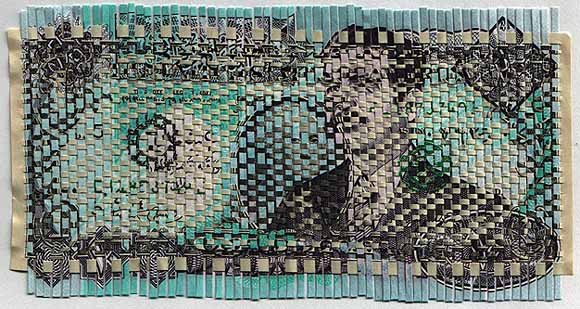
Oriane Stender, Dinars to Dollars (woven dollar bill and 10 dinar note)
David LaChapelle, he of the horrible stagy photographs, has sniffed out the latest ghetto thang: "krumping" or "clown dancing." It sounds intense and fun to watch, as described in Forward Retreat's review of LaChappelle's film documentary on the trend. ("More lyrical than the rock/pop jerks of breakdancing, clowning and krumping involve a level of physicality so intensely rhythmic that one could mistake dance practice for a gang fight. Combining hip hop, breaking, the martial arts and strip dancing techniques--just to point out a few more recognizable influences--young dancers pump their booties like machine gunfire.") The blog then issues a challenge:
Go ahead, let it rip. Scream "cultural appropriation" and run wildly through the halls of the nearest University's Anthropology department. Deride LaChappelle as a slutty Vanity Fair-contracted commercial photographer. Then see Krumped, and prove yourself wrong.Cultural appropriation will likely occur at the MTV, DVD, McDonald's movie tie-in level, given the entertainment industry's inability to produce anything original--this sounds like a natural. Where LaChappelle "bravely" led, others will follow. The challenge perhaps ought to be--how long before white kids in the burbs are doing this? Six months? A year?
I herewith offer a related counter-trend which, lacking the potential for shots of tight youthful buns, will never be as big as krumping: Kaiju Big Battel (sic). From the Boston Phoenix: "Kaiju, which means 'mysterious beast' in Japanese, is a Boston-based monster-wrestling league that stages full-scale matches, contests, and tournaments...[i]nfluenced by Japanese anime, World Championship Wrestling subplots, and the kitsch of dubbed monster-movie cult classics like Ultraman..."
more pics / more Boston Phoenix (hat tip to Kristin for the link.)
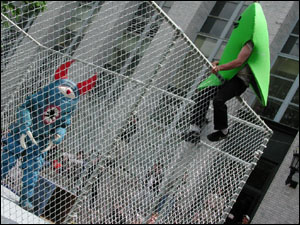
UPDATE: T.Whid politely suggests that KBB is old news but I say it's never too late to pose anything as a counter-trend to David LaChappelle.
Fuzzy think piece in the NY Times today here on the Tsunami and what it all means. A good discussion of how cataclysmic seismic events seem to come in clusters lies sandwiched between the contentious headline "The Year the Earth Fought Back" and some spurious riffing on the Gaia hypothesis, which holds that the entire world is a living organism.
The key word there is "living." To imply that the molten rock under our feet is an active (as in volitional) part of Gaia takes us a bit further back into animist mysticism than most of us should want to go. In other words, the headline and thesis might be intuitive if 100,000 had died as a result of disease or sudden release of organic chemicals into the air. That could indeed suggest that Gaia has "fought back" against our sloppy stewardship of her--that she is self-regulating to correct damage one of her component species causes.
Yet surely if Gaia exists it is in the community of living matter hugging an inhospitable ball of nickel-iron like a skin, not the ball itself. The ball's mistreatment of the skin may very well come in peristaltic spurts of volcanos and earthquakes, but the skin adjusts to that over the eons. Rock responds to the biosphere, too, of course, but lightly, in the form of erosion. To say that the biosphere sent a signal to the rocks to deform themselves and punish mankind is Old Testament hogwash--turning a nurturing mother back into the man with the spear.
More Damned Metablogging
Many thanks to Raphael Rubinstein for his nice piece on art blogs in the January 2005 Art in America, and for tossing this page into the mix. Dan at Iconoduel, another tossee, posted searchable text here, and still another, Joy Garnett at NEWSgrist, put up a scan. Garnett related the AinA piece to the recent Rhizome.org panel on art blogs I and other bloggers participated in, and also a research paper titled "Art Blogs: Why Such a Timid Emergence?" by Marie Omann, a masters degree student in Design, Communication and Media at the IT University of Copenhagen, which is published in .PDF form on T.Whid's and M.River's blog.
The panel and the paper tended to concentrate on how practicing artists use blogs, while Rubinstein focused more on the growing field of blog-style art journalism. Omann imposed especially tight criteria for her research subjects, requiring that the blogs be written by artists in their role as artists, have artistic content, and be updated daily. She then triangulated this activity within current sociological and media theory about the internet and its budding communities.
In brief, Omann mostly shrugs off the old-school Marxist view of Modernity as a community-destroying blight and posits art blogs as an example of "liberated communities," that is, "sparsely knit and territorially unbound communities based on individual choices." (Think fan clubs and terrorist cells.) Before the Internet, these "geographically dispersed social networks" already existed in our highly mobile, wired society--even participation in a biological family unit is increasingly seen as voluntary when its members live in different cities.
As for how well blogging fits into all this, let's just say my two cents were quoted at length so of course I think her arguments are great. But as I told Omann in a thank you email, she possibly oversold the idea of community within the world of visual art online self-publishing. Fault lines exist within this global village that are actually gaping, sulphurous chasms patched over with hopeful cyber-cement. Here are just a few of the divisions:
Print journalism (and its online variants) vs blogs. A subject of endless, mostly angry fascination among the art-journo-bloggers, and while Rubinstein has extended the olive branch of reciprocal fascination, it should probably be greeted with haughty skepticism. Just kidding, of course.
New York vs everywhere else. Another subject of endless fascination outside New York, but tedious to read. The discourse needs to rise above the level of lame us vs them conspiracy theories.
Artists vs non-artists. Shop talk steers the bus but others are welcome to listen in and back seat drive, assuming that's OK with James Elkins.
Gallery art vs new media art. Can anyone argue across this divide? Will the former please pay attention to the latter and will the latter please stop obsessing about not being paid attention to?
Blogging about art vs other stuff. It's silly to limit yourself to one subject in a medium that can tie you into any discourse at the click of a hyperlink.
This page promises to work hard to widen all these nascent, still largely unspoken rifts within the so-called community of so-called art blogs. In a friendly way.
Update: edited slightly to clarify that "NY vs Everywhere Else" whining is tedious universally, not just to New Yorkers. I hated it long before I lived here.
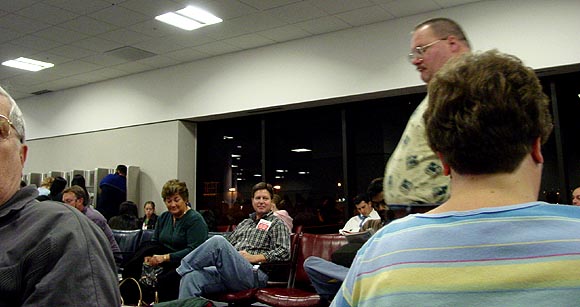

Atlanta airport, December 23, 2004. Delta flight took off 5 1/2 hours later than scheduled.
More impressions of the "Scratch Code" exhibition at bitforms, presenting computer art from the '50s, '60s and '70s. Paul asks about the Peter Vogel sculpture: I'd say its appeal is more technological than artistic--or perhaps, it's better as sound art than visual art. This gets back to an earlier post about circuit bent work being problematic as sculpture. The best work looks like it emerges casually and offhandedly as a result of a technologist trying to create a certain set of sounds, that is, as sloppy mad scientist bricolage, but as soon as it becomes self-consciously "artistic" or "sculpture-like" it loses, um, juice. Vogel has made a little cage of soldered metal sticks holding wires, capacitors, transistors, etc that cheeps and bleeps as you move around it. All the circuitry is exposed and you can visualize a certain set of probabilistic variables creating that sound even if you know nothing about electronics. The sounds are fascinating but the sculpture has to stand next to say, David Smith, who kind of set the standard for freestanding modernist sculpture, and it rather ignores all his hard work and the dialogue he participated in in favor of "making shit up"--i.e., presenting an unengaging, upright column-shape with the spidery, solder-y metallic textures of modernist knockoff mall art, or church or synagogue art. You can enjoy it on that level but you have to view it with kitsch filters firmly in place.
Manfred Mohr's prints in the same show, however, seem neither cheesy nor dated, perhaps because they are Ultimately Minimal and not trying to be expressive. They speak purely and eloquently to a techno-design-acclimated generation conversant with the likes of Designers Republic CD covers; they could also be cool scores for music by glitch-and-hiss musicians. Carsten Nicolai's spare, scrupulous visual work also comes to mind.
I hope that when I'm in my 70s I won't be haranguing bloggers (or whoever replaces them in the communication food chain) by saying "I was the first artist to make paper quilts with computer output!" or whatever. Just got a comment from Manfred Mohr, who wishes the record to reflect that he used the "incomplete open cube" before Sol LeWitt did and is mad that I said he "copped" it from LeWitt, in my discussion of the "Scratch Code" show at bitforms. He seems to have missed that my review was complimenting his work. His peevish comment and my petulant reply are here.
Traveling for the Christmas holidays, as Bill O'Reilly would call them. Got to spend 6 hours in the best place in the world: the Atlanta airport. Plane supposed to depart at 7:22 pm left at 12:40 am. These are pictures from the last swing though this carpeted Valhalla, in 2003. New, similar shots coming soon.

Above, an image by Alex Wilson, from a page presenting his last 24 years of Christmas Cards. Moving from pagan to secular idolatry, Alex also found this photo of the Joe Louis Memorial in Detroit, which I would characterize as "Giacometti meets Diego Rivera meets Sun Ra":

Plus maybe Dawn of the Dead. I mean, that's a severed arm, right? This is where a little Modernism gets us in trouble.
UPDATE: D'oh, just realized this was by Robert Graham, a sort of classicist-minimalist (or minimalist-classicist) dude who specializes in detached, fetishized bodies and body parts--often of toned young females.
Justin Raimondo tries to make sense of the latest poll results on Bush's Folly:
"For the first time," a Washington Post-ABC News poll shows, "most say the Iraq war was a mistake." Not to worry, however, because "a strong majority of Americans, 58 percent, support keeping military forces in Iraq until 'civil order is restored,' even in the face of continued U.S. casualties. By a slight margin, 48 percent to 44 percent, more voters agreed with Bush's position that the United States is making 'significant progress' toward its goal of establishing democracy in Iraq." But, oh wait: "Yet, by a similar margin, the public believes the United States is not making significant progress toward restoring civil order." To top it all off, 70 percent say the present casualty rate is "unacceptable."So in the face of all this contradictory data, the New York Times sends a reporter out to "talk to America" and sums up the findings in this (online) headline today:
Fighting On Is the Only Option, Americans Say"Fighting on"--what a crock. It's Vietnam all over again. Growing up, I remember well the mantra "We can't pull out of South Vietnam, there will be a bloodbath." Meaning civil war and reprisals, but as it turned out the bloodbath in Vietnam was the one we caused by staying and bombing and defoliating year after year. Iraq is even worse, though, because we out-and-out invaded it. As Raimondo reminds us:
Having bombed the nation's physical and social infrastructure into piles of blood-stained rubble, disbanded the Iraqi military, marginalized the highly educated and secularized Sunni elite and driven them into a destructive and increasingly successful insurgency – we can't leave until we establish the "civil order" destroyed by ourselves to begin with.The "only option" is to pull out our troops and offer financial reparations (and help to refugees) for the havoc we caused. Then impeach Bush for ginning up the phony WMD threat. We're the 800 pound gorilla, we can do whatever we want. Last I heard there was no other global superpower around to "interpret this as a sign of weakness." Terrorism is the price we pay for maintaining 700 military bases around the world after the cold war ended.
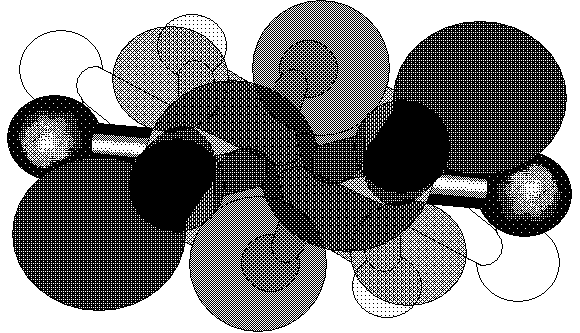
For any bloggers having comment spam problems, there are links at this post addressing some of the issues, particularly with blogs running Movable Type. In a nutshell, comment spam is an unscrupulous use of the blogger's comment feature, where a robot leaves URLs to drive up traffic for certain crapola sites, or create artificial traffic, or whatever. A big source of the problem is compromised Windows machines that act as slavebots to send out the spam. Meaning some popup trojan could have gotten into your PC, causing your computer to send out spam without your knowledge while you're websurfing. The real villain here is Bill Gates--it all goes back to Microsoft's slimy tactics during their antitrust suit where they argued that Internet Explorer was an integral part of their operating system and not some detachable, independently competitive feature. By actually integrating the two things, they made everyone's PCs much more vulnerable to hackers. Way to go, Microsoft!
Time Magazine's Person of the Year.
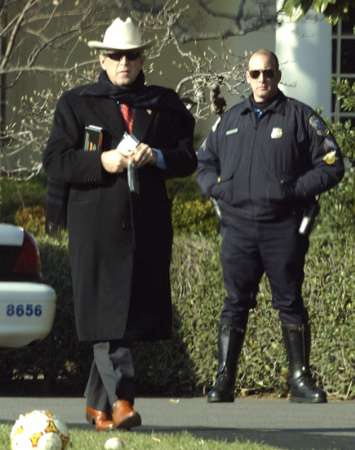
Some scary shit found on Digby's site, with lyrics to match ("We doin' big pimpin, we spendin' cheese / We doin' big pimpin' up in DC"). I've been trying to have a moratorium on Bush images because I think even the satirical ones just add to his cult, but this one belongs in the horror hall of fame. The American Ghaddafi? Russian mobster? A friend says he looks awfully prissy for a cowboy.
TOM MOODY WEBLOG TOP TEN 2004
1. Site Specific Art is Dead; Long Live.... According to this text from the year 2035, the dinosaur finally died when artists ran amok in the Saarinen airport terminal; meanwhile, the small mammals of wireless and GPS-based art stirred at Spectropolis 2004 and the psy.geo.CONFLUX.
2. Diana Kingsley at Leo Castelli. This artist's subtle humor has been evading the New York art world for years. The New Yorker is the latest not to get it.
3. Ross Knight at the Sculpture Center. More art too subtle for Saltz and the pros.
4. The Infinite Fill Show at Foxy Production. Disclosure: yrs truly was in this show (along with 92 other artists).
5. Four-way tie: Banks Violette at Team, John Parker at Front Room, Joe McKay at vertexList, Paper Rad at Foxy Production (and online).
6. Loretta Lux. Powerful images of ideal children combine painting, photography and digi-manipulation, made even more meme-worthy by resizing at a web-friendly 300 x 300 pixels.
7. Chris Ashley, Jan - December 2004. Abstract painter moves to web, uses your browser to make paintings, blows away competition.
8. SCREENFULL, July - December 2004. If Sigmar Polke were in his 20s today and/or Richard Prince surfed the net instead of painting, this is what they'd be doing. If only it could be commodified...
9. Michelle Handelman in Bryant Park. The performances were memorably quirky, the summer day was beautiful, Bryant Park was beautiful...
10. Duncan Hannah at JG Contemporary/James Graham & Sons. Weirdly affectless Hopperesque work by one of New York's best painters, whose work has long been too subtle for...oh never mind.
Honorable Mention: The art world's efforts to end the Iraq War and throw the current bums out of office, even though both have so far failed.

1965 watercolors by Gene Klebe. Above: Clean-Up After Marble Mountain Battle; below: Operation Market Time.
Art worlders, including many in the blogosphere, continue to give salutatory high-fives each time a new series of drawings appears by Steve Mumford, an artist who has been unironically embedded with the troops in Iraq. Carol Kino did it in the New York Times as well, this week. This page has complained (here and later here) that Mumford's a rather ham fisted draftsman and absolutely on the wrong side of the war issue. Bush has a snit because Saddam tried to kill his Daddy, the neocons seek a permanent American "footprint" in the mideast, thousands upon thousands needlessly die from American bombing and the subsequent chaos, and there's Mumford sanitizing the mess. The art world marched to stop this horror but out of friendship (or simple bewilderment) enables Mumford to do his thing.
Commenter Mr. Potts likes Mumford's work, and steers us toward this Dept. of the Navy page of sketches and paintings from the Vietnam era. (The pictures in this post come from there.) These are indeed Mumford's forerunners: official, clunky court room style art that supports the war effort--except the two images here, by Gene Klebe, actually have more punch and clarity than Mumford's washy drawings. But the art world wouldn't fete the artists on the Navy's site and give them shows at White Columns. They'd be seen as "mere illustrators" who wouldn't get past the velvet rope.
In the Times article, Mumford says he went to Iraq convinced it was a mistake (which you would never know from his bland sketches) but now having contact with ordinary Iraqis and seeing their joy at the ending of the horrible Saddam years has him "on the fence." He's more than that, as his writings clearly show--Karl Rove could have ghostwritten the diaries. Reading them gives you a good sense of the mental contortions our troops have to go through to convince themselves they're on the side of the angels. But the unreconstructed colonial, who thinks it's his right to document and help these sweet, misguided people, often shows his face. The latest diary veers between the narcissistic and the maudlin, and sometimes you get the feeling that Mumford is over there as a thrill seeker, playing Army in a country he has no ultimate stake in. Still weighing whether to post excerpts--they make him sound pretty bad, and he's really just politically naive.

Below: Duncan Hannah, from a show last spring at JG Contemporary/James Graham & Sons, New York, a painting based on one of the photos in Antonioni's Blowup. Hannah is of the '80s appropriation generation but never got his due as a theoretical painter--he's too low key and modest in his artful (and oddly affectless) borrowings and montagings of old magazine illustrations and movie photos. Nevertheless he keeps working and showing, a kind of rootless, misunderstood existence in the uptown-style painting galleries. He has his cult, but deserves broader appreciation.

Tonight I'm going to hear jenghizkhan performing live at The Psychasthenia Society, Galapagos Art Space, 70 North 6th Street Williamsburg, Brooklyn (between Wythe and Kent). I did an interview with him here, and am curious to hear the new music he's been writing. He goes on first at 10 pm. It's free.
Tomorrow night (Thursday, December 16, 6 pm) Cory Arcangel is speaking up at Columbia U in a series called "Open Source Culture: Intellectual Property, Technology, and the Arts." Previous speakers included Joy Garnett and Jon Ippolito. Cory is strongly advised to phone this lecture in from an undisclosed location.
Everything foul about the current copyright regime is summed up in Eric Fensler doing slam-bang satirical mashups of GI Joe PSAs and getting a letter from Hasbro's lawyers telling him to remove them from his website. Hmmm, just revisited my earlier post on "Making art in the age of abusive copyright enforcement" and find that only two options for artists are still viable. Here's what I recommended six months ago to avoid the lawyer letters:
1. Stay poor. The humorless twit who sued Jeff Koons over that "string of puppies" photo would never have done it if Koons hadn't been an "art star." Very few people sue to make a point (except RIAA); it's too expensive. [Whoops, post-Fensler this now seems excessively optimistic--strike this one.]2. Record live versions of other people's songs, or song fragments, for the sole purpose of sampling them--you avoid the "master recording" fee for the sample and only have to pay the "publication" fee. Just kidding: this is actually done by the big-bucks hiphop performers, as described in the Chuck D/Hank Shocklee interview, but it sounds fake as hell--essentially having a lawyer as a creative partner.
3. Stay several steps ahead of the shysters by mutating the sounds so they're virtually untraceable. A lot of drum and bass producers do this. You don't get that bang of recognition ("Oh that's Richard Dawson in Running Man!") but the texture of the sound is yours to play with. [Dicey after the 100 Miles and Runnin case, which applies to snippets of samples. Strike this one, too.]
4. Make completely original art. No more samples, no more collage, it's back to the Modernist dictate "make it new." It's always possible you heard or saw something subconsciously that crept into your work and could get you sued, but creativity isn't just about mixing up other people's stuff. (Dumb, I know; I just put it in in case Jed Perl stumbled across the page).
I missed La Superette this month, the annual artist mega-merch table event organized in New York by Tali Hinkis, and I'm sad because I would have been interested in (among other things) these Perler Bead floppies by Kate Pemberton:
More Perler iron-and-fuse bead work is depicted here in my writeup of the Mondo Mondo Trading Post. I found the Pemberton image via Your door to explore, a good collection of links to the kind of komputer kraft stuff I periodically post about here (including links to here, but that's not the only reason I mention it, and also some typical dumb LiveJournal fodder, like "what type of _______ are you" quizzes). I also learned there about Mr. Ministeck (Norbert Bayer) who makes pixeled images with Ministeck, another brand of fuse beads first made in Bavaria in the 70s. I had seen his Pac Man image but didn't know what it was.

Awesome. Related topics of interest from the blog vault:
Joe Beuckman bead works; Jason's Pokemon bead designs drawn in MSPaint.
Bill Davenport needlepoints 1
Bill Davenport needlepoints 2
And one more relevant item from La Superette, by FLUORESCENT F and SISTAZ 4EVER (Frankie & Katie Martin):

Ni-i-ice. Just noticed this: the generous folks at Hasbro sent Eric Fensler a cease and desist letter telling him to remove his hilarious, remixed GI Joe public service videos from his website. Citing copyright and the usual crap. Millions have enjoyed these vids but we can't have people laughing at GI Joe, can we?
Don't know if this video, opening at Momenta Art this Friday, December 17, 6-9 pm, is good, but the description from the press release cracks me up:
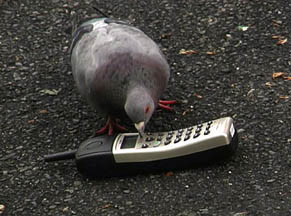
"Lisa DiLillo’s video and photographic work focuses on the peculiar interactions that take place between human constructs and other life forms. In her video piece This Call May be Monitored, a segment of a larger body of work entitled "Encounters," a group of pigeons gather around a lost cell phone in an urban park. As they randomly peck at the keys, they inadvertently dial a corporation that employs a voice recognition system. This results in a series of misinterpretations and technological cul-de-sacs. The fleeting sense of triumph over a technology meant to convenience the corporation over the individual quickly dissipates as the viewer recognizes that the corporation itself is not affected by this encounter whatsoever."
The description of the other artist's show is Marxism 101: "Exquisitely crafted and making clear reference to post-minimalism, Simone Leigh questions the bourgeois strategy of that formalist movement, which favored materiality over cultural meaning. The titles of these works mirror this formal disconnect, referencing the “Cake Walk” dance that was adopted by white, southern society. The cake walk was actually created by slaves to mock the strut of their masters. But just as the slave masters did not care what the dance was meant to emulate, the essentialism of minimalist and post-minimalist masters did not take into account either the national origin of their raw materials or the ethnocentric grounding of many forms considered to be essential or aesthetically pure. By remaining conscious of the economic and social connotations of her sculptural forms, Leigh not only evokes an underlying history of colonialism, but she also reminds us of its presence in an art world that continues to coolly reject any reminders of the world outside of its self. [Actually the post-Minimalists, principally Eva Hesse and Richard Serra, were edging away from the "de-cultured," machine-tooled art of Judd, etc. towards what Robt. Atkins calls "the embellished" and what I'd additionally call "being-in-the-world." Hesse "feminized" machine-tooled art with disposable, organic elements, and Serra's first works were basically earthworks. I don't think any great artists, Minimal, post-Minimal, or even the AbEx'rs, were pure formalists. Only an idiot talks about art solely in terms of color, symmetry, etc.]
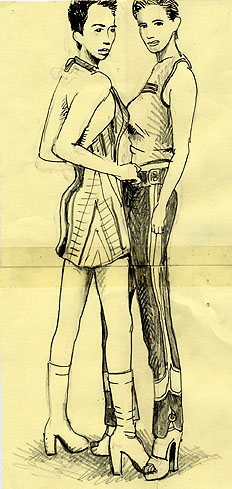
Those reading this weblog outside New York should know that people in this city hate Rudolph Giuliani. Before 9/11/01 he was a nudzh whose tenure was memorable mainly for the bullying of sidewalk vendors and people dancing in bars, and racism. His current standing derives from looking televisually calm on 9/11 while Bush flew cluelessly around the country--it's an act that played well outside the five boroughs but no one here was impressed, because we know what a camera hog he is. As Al Sharpton said shortly after that horrible day, "The people didn't come together because of the mayor, they came together because of the victims. They would have come together if Bozo had been mayor." (Some people thought that was "too much" at the time.)
So imagine a collective "aah" of pleasure this week as Giuliani's personal pick for Fatherland Security, Bernard Kerik, went down in flames amid a host of accusations of...irregularities. Here's what the New York Press said a few days ago, when it looked liked Kerik would sail through confirmation hearings with minimum press scrutiny:
But it needs to be said: Not only is Kerik unqualified for the Homeland Security post, the politics behind his candidacy are built upon a myth—the myth of Rudy Giuliani and 9/11. Sustaining this myth requires keeping a few facts from bubbling up the memory hole, such as: Rudy's headless chicken act on the morning of the attacks; his idiotic decision to place the city's emergency management center—and illegal fuel tanks—in WTC 7; his prompt melting of the wreckage, thus destroying the evidence from the biggest crime scene in American history; and his baffling negligence in preparing for a likely second attack on the towers following the Trade Center bombing of 1993, as evidenced by the lack of coordinated planning between agencies and widespread equipment dysfunction on 9/11.
The Rudy-9/11 myth is crucial to Kerik's nomination, because without this myth there is no Rudy the National Player, and without Rudy the National Player there is no nomination of brusque outsider Bernie Kerik to a major cabinet post in Washington. Rudy has always been upfront about his hand in Kerik's rise from pony-tailed narc to NYPD chief. And just as it was Rudy—and 9/11—that allowed Kerik to enrich himself in the terror biz, it was Rudy who put Kerik's name on President Bush's lips last week.
The following came in as a comment to an earlier post on Pierre Huyghe's "Annlee" project. I thought it was kind of dumb that Huyghe bought the rights to an anime character and then changed her physical appearance before making her available as "open source art." If the art dealt with branding why not use the brand you paid good money for?
I am a graduate student at NYU writing about Pierre Huyghe. [...] Considering how explicitly critical he is of the act of representing and defining, he sure is quick to outline what his work means. I recently attended his talk at the New School and fell asleep.I don't know enough about Huyghe to know if his "rap" over-determines his art. Possibly that happened with the Annlee project. But I only wrote about the premise and one writer's take on it, not the exhibit based on the premise.
The only Huyghe pieces I know well were the ones at the Guggenheim in 2002, the film of high-rise apartment building lights blinking on and off to a techno beat and the disco dance floor playing Satie. I liked the building piece, Les Grands Ensembles, 1994-2001, quite a bit and the music by Pan Sonic and Cédric Pigot particularly wowed (Pan Sonic rules). We probably don't need Huyghe informing us "These subsidized public projects ended up being an architectural and social failure, They were a corruption of Le Corbusier's social and architectural Modernist theory" but I don't mind knowing that. He even tells us what we see with our own eyes: "Without beginning or ending, the two low-income towers dialogue in a strange Morse code given by the light of their respective windows, a blinking existence." Which saved me having to write that.
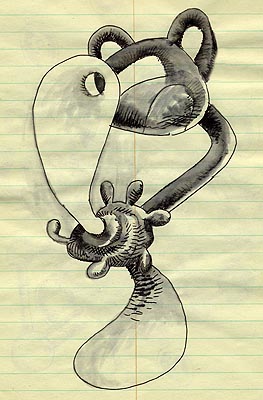
New track: "Taser Squad" [mp3 removed].
Dark, gloomy, bare-bones techno where the bolts pop off the synthesizer and the circuits audibly fail.
My complete musical works in .mp3 form are here (19 tracks since 1998!)
Housekeeping: my review of Susan Canning's "Paradise/Paradox" exhibit published in Sculpture last spring is posted in full text here. Also, the "selected critical writing" page has been revamped slightly, putting print publication, web-only writing, and interviews under separate headings. The criteria for "selection" were very exacting: basically anything I had in soft-copy form that didn't have to be retyped.
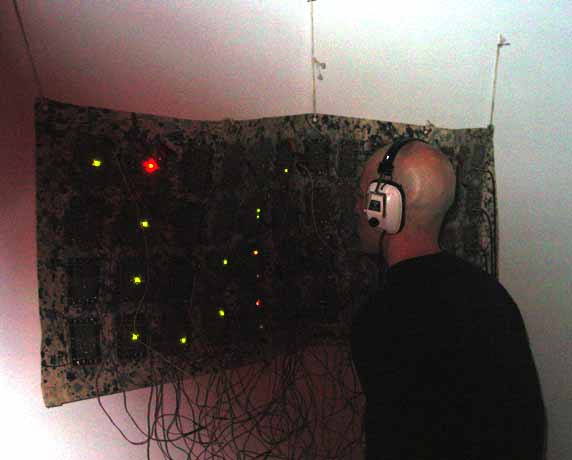
More on the circuit bending genre. The painterly and/or sculptural aspirations of benders can be problematic, especially if the result is sci fi cliche, but the physical aspect can be engaging, too. So we're looking for good examples of circuit bent pieces that are visually, musically, performatively tight. I've posted work by Peter Blasser (aka Peter B) before; above is another piece of his (I think it's his) that I photographed at the Shinth Tour at Deitch last year. It reminds me of Eva Hesse's Metronomic Irregularity II (below) only with a sound component: actually it's as if her work looked forward to a time when sound would complete the idea.
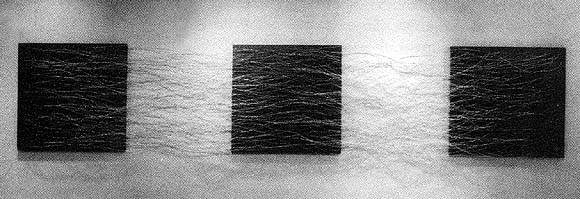
My memories of the Blasser piece are sketchy. I don't know what the circuit board/sound-producing module thingies are. The cloth is a paint-spattered rectangle of canvas that's like a parody of a bad Pollock, but the expressionism component is relevant, particularly in light of the Hesse, which has been described as an attempt to reconstitute Pollock in the vocabulary of '60s minimalism. The sound you hear through the headphones is the sublime product of random crisscrossing connections in the circuit field: chirping robotic crickets, but with pauses and subtleties making them slightly haunted and Eno-esque. The blinking lights were their ephemeral, firefly-droid cousins. I don't know if there was any programming involved in the routing of the signals, or if it was solely a product of hardwiring parts. I guess I don't really care. More detail about the piece would be appreciated.
UPDATE: via cory, a momus-sponsored page devoted to Peter Blasser's old band the Gongs. the mp3 doesn't work but great photo. also link to CD (don't know about availability).
The Democratic Leadership Council--the pro-corporate, pro-war wing of the Democrats that helped bring us Bill Clinton, has been busy lately trying to disassociate itself from Michael Moore and the rest of us who oppose Bush's wars. Of course the antiwar position is the sane position and the idea of US Empire Forever basically nuts, but for the sake of argument let's say we and Moore are extremists. The Republicans won in 2004 by embracing their extremist elements (and cheating): the corporate hotel porno-pushers cynically worked hand in hand with religious fundamentalists. The Democratic corporatists repeatedly fail because they can't do that. This is probably because the Moore wing's critique of the overall corporate program is more devastatingly effective than the fundies', who don't have such a critique because they haven't figured out who their real enemies are--they think gays and abortion are the problem.
And for trolls who think we're endorsing Stalin here, "corporate" or "corporatists" refers to crony capitalists, missile mongers, and sundry multinationals gaming the system against the greater interests of the larger number of US citizens, as well as exploiting labor at home and abroad. And not everything about the DLC is bad--check out this anti-Bush statement by its policy director Ed Kilgore.
Pixar's latest The Incredibles is incredibly derivative but exhilirating. Here's just a few borrowings: society outlaws and shuns masked adventurers (Alan Moore's Watchmen); second-rate series sidekick grows up to be demonic villain (Alan Moore's Miracleman); villain has private tropical island fortress (Bond films); high speed chase through the trees (Return of the Jedi)--etc. etc. I thought I'd given up on rubbery skinned Pixar universe after Nemo but the helming of Iron Giant director Brad Bird brought me back; he's a terrific visual storyteller even when you know every...single...thing...that's...going...to...happen. And I realize the filmgoing demographic demands "family values" but the working Dad, childraising Mom, 2.5 kids in a 50s suburban tract home is an impossible (or undesirable) ideal for so many people today it's irritating that Disney keeps pounding it in as a "norm." Where's grandma, or stepdad? Not to be too much of a grouch, though, because it's genuinely uplifting watching the beat-down kids getting to finally use their "powers," no matter how well adjusted and normal (i.e. privileged) they are.
Banks Violette at Team, 2004
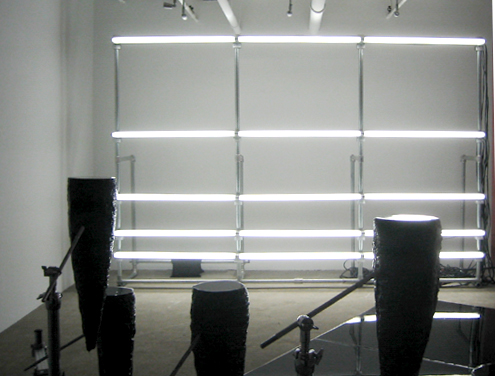

Michael Phelan at Andrew Kreps, 1997


The point here being not that there's plagiarism but two emotional workings of a very similar Minimalist theme. Both artists use polyurethane-coated planks of foam, skeletal piping and fluorescents--Phelan to evoke a Valley-boy world of swimming pools and tanning booths and Violette the drums, Stygian caverns, and concert stages of black metal (or black metal by way of Berlin?). Institutions have no memory so I appointed myself.
UPDATE: I need a new screen and/or computer. Just noticed on someone else's machine that the Phelan detail had spots all over it. (Mostly) fixed now.
I Can Crawl Again (in Chelsea)
Jacco Olivier, MARIANNE BOESKY, 535 West 22nd Street, 2nd Floor, November 13–December 11. William Kentridge meets LeRoy Neiman meets the Discovery Channel. Small animated paintings projected from thigh-high plinths directly onto the wall. This is what Donald Moffett tried and failed to do--make lush, moving, painterly paintings. Will someone buy one of these and burn a DVD for me?
Daniel Lefcourt, TAXTER & SPENGEMANN, 504 W. 22nd Street, November 19–December 18. Paintings of lumps of coal on pristine, high-commodity linen. Jet black juicy paint crosshatched with strokes as if from the Zen master's rake. Unrelenting Germanic rigor. Ponderous titles based on books of philosophy.
Martha Rosler, GORNEY BRAVIN + LEE, 534 West 26th Street, November 01–January 30. Extending Richard Hamilton's "What makes today's homes..." collage to feminism and antiwar themes. Lots of hot babes posing nude, working in the kitchen, mowing lawns in stretch pants. Biting wit occasionally goes overboard and gets too obvious with war dead juxtaposed over suburban interiors. The best are the Austin Powers era ones.
Art Battle: Richard Kern vs. Lily van der Stokker, FEATURE INC., 530 West 25th Street, October 23–December 11. Kern's photobooks of hot downtown babes are possibly the most thumbed, greasiest items at the midtown Virgin Megastore. Here he's not as skanky, perhaps reflecting the modifying influence of van der Stokker's gaily colored wall-hugging daybed sculptures, which hold the line for permanent presexuality.

I enjoyed blogger Michael J. Totten's photo tour of Libya (hat tip to Dennis). Totten captures the bleak Soviet-style architecture in Tripoli, vanishing Berber dwellings in the Saharan outback, and some beautifully-preserved Roman buildings, all framed against the empty desert landscape--in fact, there are hardly any people in the photos so the country looks weirdly depopulated. Of course, Ghaddafy has his heroic picture everywhere, which Totten mercilessly ridicules. But wait, isn't Moammar a good guy now that Bush's aggressive warmaking convinced him to "turn in his nukes"? Thankfully we don't have a Libya-esque, state-sponsored cult of personality in this country.

Whoops, well, I'm sure this billboard in Florida paid for by the Bush-backing Clear Channel radio chain is a fluke.
Loop Collection Updated.
Techno Loop [mp3 removed]
Proto-Trance Loop [mp3 removed]
Psychedelic Rock Loop [mp3 removed]
![]() P0rn Loop [mp3 removed]
P0rn Loop [mp3 removed]
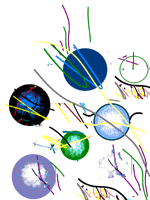


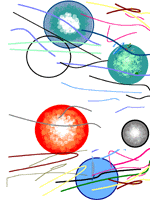



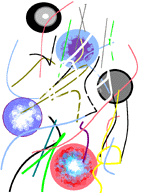
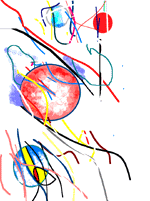









Filled with random violence, slapstick, silly names, toilet humor, and various other signifiers of lowest-common-denominator satire, Greaser's Palace doesn't so much reward its audience's patience as punish it. Glacially paced and filled with enough dead time and shots of people walking and crawling to fill a half-dozen Bresson films, [it's] well-acted and handsomely filmed but unrelentingly dull. Perhaps worst of all, for a film that aims to shock and offend, its juxtaposition of show business and divinity now seems downright quaint. As a product of an unusually adventurous time in cinema history, Greaser's Palace has perverse appeal. As a comedy, it's virtually unwatchable. —Nathan Rabin

Max Schumacher: You need me. You need me badly. Because I'm your last contact with human reality. I love you. And that painful, decaying love is the only thing between you and the shrieking nothingness you live the rest of the day.
Diana Christensen: [hesitatingly] Then, don't leave me.
Max Schumacher: It's too late, Diana. There's nothing left in you that I can live with. You're one of Howard's humanoids. If I stay with you, I'll be destroyed. Like Howard Beale was destroyed. Like Laureen Hobbs was destroyed. Like everything you and the institution of television touch is destroyed. You're television incarnate, Diana: Indifferent to suffering; insensitive to joy. All of life is reduced to the common rubble of banality. War, murder, death are all the same to you as bottles of beer. And the daily business of life is a corrupt comedy. You even shatter the sensations of time and space into split seconds and instant replays. You're madness, Diana. Virulent madness. And everything you touch dies with you. But not me. Not as long as I can feel pleasure, and pain... and love.
[Kisses her]
Max Schumacher: And it's a happy ending: Wayward husband comes to his senses, returns to his wife, with whom he has established a long and sustaining love. Heartless young woman left alone in her arctic desolation. Music up with a swell; final commercial. And here are a few scenes from next week's show.
[Picks up his suitcases and leaves]
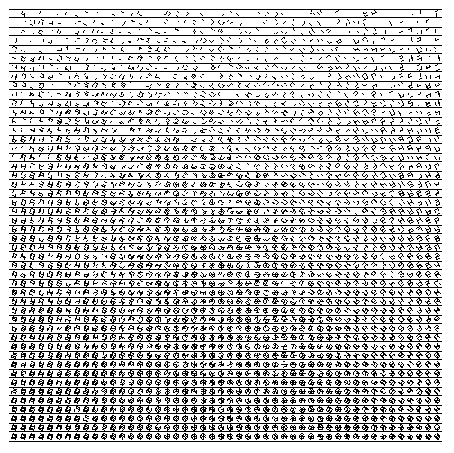
Above, a work by Manfred Mohr.
Mohr was born in 1938 in Pforzheim (Germany). He studied lithography at the Ecole des Beaux Arts, in Paris. He turned from traditional painting to the computer in 1969 to realize his artistic interest in Constructivist artforms. He focused his artistic vocabulary and aesthetic expression by working only in black and white, not reverting to a color palette until 1998, using a plotter as output from the computer.Mohr's work is on view in a show at bitforms called "Scratch Code," consisting of "computational works work from the 50s through the 70s: plotter drawings, prints, sculptures, film." The above piece (a similar one is in the show)
Mohr: The computer became a physical and intellectual extension in the process of creating my art. I write computer algorithms i.e. rules that calculate and then generate the work which could not be realized in any other way. It is not necessarily the system or the logic I want to present in my work, but the visual invention which results from it. My artistic goal is reached, when a finished work can visually dissociate itself from its logical content and convincingly stand as an independent abstract entity.
The experience of the work goes exactly counter to "the look of thought," particularly if thought is understood as classical expressions of logic. For such expressions, whether diagramatic or symbolic, are precisely about the capacity to abbreviate, to adumbrate, to condense, to be able to imply an expansion with only the first two or three terms, to cover vast arithmetic spaces with a few ellipsis points, to use, in short, the notion of et cetera.Update: wording changed based on peevish correction from Mohr: see comments.
[....]
In Variations of Incomplete Open Cubes....what we find is the "system" of compulsion, of the obsessive's unwavering ritual, with its precision, its neatness, its finicky exactitude, covering over an abyss of irrationality.
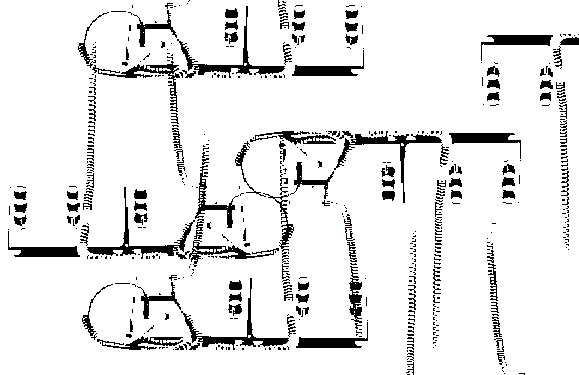
It sure looks like the Republicans stole the Presidential election again in 2004, after Bush squeaked in with rampant cheating in 2000. That's going to be the position of this page, at any rate. As the AP article excerpted below shows, the Ohio numbers came in much closer than initially projected, once the count was finalized. Factor in the 2 or 3 percent "spoilage" ballots customarily thrown out for bad chads, etc. (which reduce minority votes), electronic voting machine irregularities, and the last-ditch push by Republicans to keep voters away from the polls, and in all fairness a recount should be called for. Until then, it's fair to scoff at Republican claims to represent the majority of this country or (more laughably) to have a mandate. Bush owes his win to energetic Christian zealots, corporate-class cheaters, and wimpy Dems who fear what people might think if they fight.
President Bush's victory over John Kerry in Ohio was closer than the unofficial election night totals showed, but the change is not enough to trigger an automatic recount, according to county-by-county results provided to The Associated Press on Friday. Bush's margin of victory in the state that put him over the top in his re-election bid will be about 119,000 votes, which is smaller than the unofficial margin of 136,000, the county election board figures showed. That means Kerry drew closer by about 17,000 votes. The margin shrank primarily because of the addition of provisional ballots that were not counted on Election Day and were not included in the unofficial tally. Overseas ballots also were added to the count in all 88 counties. Secretary of State Kenneth Blackwell will certify the results Monday. The president's margin of victory was about 2 percent, not close enough to require an automatic recount. That happens only when the difference is 0.25 percent or less. Bush beat Kerry nationally by 3 percentage points.

Patlabor - The Mobile Police: Tokyo Bay .GIF
A few more (nerdy) thoughts on circuit bending and whether rewriting software for old games, toys, appliances, etc. should be included in it. Paul Slocum got lumped into the discussion because he participated in the recent Bent festival in New York and his modified Epson printer--as opposed to say, the vintage computers he works with--seems more in the bending spirit of altering consumer devices we don't normally think of as music-producing. That piece I would call bent, perhaps software-wise as opposed to hardware-wise (Slocum proposes "circuit folding" but that's not as blunt or catchy as "circuit bending"). As for whether bending produces boring work, Slocum notes in the comments that "lot of those ['80s] toys and keyboards sound crazy and awesome whether they're modified or not." Good point; j, on the other hand, says:
Circuit bending makes useful audio material if you have a well 'bent' machine which when in the hands of an experienced bender is mostly calculated as well.I'm for extending "circuit bending" to include hacking, with educating our ears to hear the distinctions good but still optional. ("For additional credit, is this [insert sound here] mechanically bent, virtually bent [i.e., within the program], or hacker bent [i.e., made by rewriting the program]?") I have a slight stake in this, having made some visual work that could be called circuit bent, even though it involved neither programming nor working within a program nor even getting out the soldering gun. Any citations to The Wire or Electronic Musician or other places where this issue might have been discussed would be appreciated. Also, it'd be great to hear more from Paul about the "bends for the Fisher Price Pixelvision video camera" he mentions--haven't seen any work done with that machine in quite a while but what I saw was inspiring.
That said, circuit bent machines' random nature are also an asset. They can provide phrases of sounds that just could not be made up in one's head.
I do think the distinction made between circuit bending and folding is interesting but one is not necessarily better than the other.
UPDATE: Slocum continues to object in the comments to being called a circuit bender. I guess my thought would be, if someone asks you to be in a bending festival again don't do it. You'll have to trust me that the scene in NY is interesting. I don't know how you can judge it surfing around the internet, or living in Dallas (sorry to my friends that stay, but you need to get out of that Baptist hellhole). The definition of bending is as expansive as you want to make it.
A while back I got really mad on hearing Harry Nilsson's lovely and quirky song "He Needs Me" in a shoe commercial and wrote a post where I used the F word a lot. Nilsson was an interesting musician and it was nice hearing "Put the Lime in the Coconut" in a Williamsburg bar recently. "You're breakin' my heart, you're tearing it apart, so fuck you" was also a groundbreaker in its day. Anyway, aspersions were cast on the Nilsson estate over the shoe thing and an anonymous commenter took me to task for it:
regarding your harry nilsson rant... i guess they don't call you moody for nothin'. after harry nilsson's money manager, Cindy Sims, stole everything from him and was sentenced to prison, Harry was forced to try to sell some of his songs for commercials... it doesn't surprise me that his songs are still being used now in commercials... after his fortune was stolen.Assuming this is true, sorry.
harry singing a ban deodorant ad...
